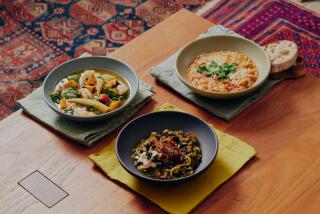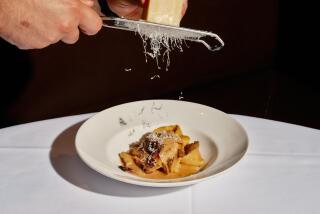How to Feed a Cold : The Great White Way
For colds, the flu, fever, upset stomach and general indisposition, Italians advise una dieta in bianco. Although this literally translates as âa white dietâ and many of the foods are indeed white or light in color, its larger meaning embraces foods that are easy to digest--mild rather than highly seasoned, cooked without tomato and prepared with great simplicity.
Beef broth is part of una dieta in bianco . It is Italyâs version of our chicken soup. The broth must be absolutely clear, strained of every impurity and completely free of fat.
In his 1890 cookbook, âLa Scienza in Cucina e LâArte di Mangiare Beneâ (âCulinary Science and the Art of Eating Wellâ), Pellegrino Artusi gives a recipe he calls âbroth for the sick.â Given to him by a highly esteemed doctor, the recipe involves layering thin, lean slices of veal or beef in a pot, adding water to cover, then covering the pot with a plate filled with water and replenishing the water in the plate as it evaporates. The broth is cooked for six hours at a barely perceptible boil. The final 10 minutes should be at a hard boil. Then the broth is strained through a fine cotton cloth. Artusi claims the broth will be of fine color and highly nutritious. He doesnât mention whether or not it cured his sick friend.
Sometimes freshly cooked pasta is added to broth--small shapes such as tiny stars, pasta resembling grains of barley ( orzo ), watermelon seeds ( semi di melone ) and other delicate cuts such as capellini . The only seasoning is grated Parmesan cheese. Other cheeses are too strong; Pecorino Romano, for instance, has more salt and tang than Parmesan and is not used.
Pasta is also used in a water-based cross between a soup and a sauced pasta. Thin pasta such as capellini or vermicelli is cooked in a generous amount of water, then partially drained, leaving behind just enough moisture that the pasta is a little soupy. The cooked pasta and the cooking water are placed in a serving dish and tossed with a little unsalted butter and un velo of grated Parmesan cheese (just a little on top covering it like a thin veil). The butter and cheese are always added to the cooked pasta away from the heat to keep the dish as light and digestible as possible. When a little more protein is called for, a small amount of very fresh ricotta can be placed in the bowl and thinned with some of the pasta cooking water before the pasta is added. Look for ricotta made by small companies specializing in fresh Italian cheeses to get the creaminess found in real Italian ricotta.
Rice is also included in the dieta in bianco and is cooked in the same way as pasta. Although the thought of using cooking water as part of a dish may seem odd, using high-quality unprocessed rice and imported hard-wheat dried pasta produces cooking water with flavor and nutrition. It also helps to extend the butter, olive oil or cheese, allowing you to use less to flavor an entire dish.
The appendix of Artusiâs book, entitled âCucina per gli Stomachi Deboli,â literally, âCooking for Weak Stomachs,â includes selected recipes from the book that he feels are appropriate for those who are âolder, ill, debauched, or weak by natureâ (although he says, rather derisively, that, at the time of writing his book, having a poor digestion seemed to be in fashion). Some recipes go beyond a strict dieta in bianco but basically follow similar principles. A few of his most-appealing suggestions include broth-based bread and bread-crumb soups, soups made with small dumplings of semolina, and Zuppa Regina , a soup made of pounded chicken breast and almonds, topped with small cubes of bread crisped in a little butter.
Frittatas are apparently approved of--especially asparagus--but he warns against serving eggs either raw or overcooked. As for vegetables, he suggests preparing sformati , mild savory puddings made with finely chopped cooked spinach, cardoons, artichoke hearts or fennel bound with bechamel and eggs, baked in the oven and served unmolded. He cautions against raw vegetables--even in salads--and instead suggests cooked radicchio combined with beets. He also likes asparagus and green beans, though they should not be served al dente , but thoroughly cooked and dressed with a few drops of olive oil and lemon juice. Boiled beef and chicken are also acceptable.
Most raw fruits are included in his list of foods for stomachi deboli , as long as they are in season and completely ripened, though he makes exceptions for cooked apples and pears, and a compote of pears and apricots. He advises against rich pastries, cautioning that they are totally indigestible, though my motherâs grandmother in Italy always brought rum babas --made of brioche generously moistened with sugared rum syrup--when visiting sick friends or relatives. According to her, the rum was good for the sick because it revived them. Artusi suggests avoiding liquor altogether, since he feels abuse could prove fatal to a weak digestion. But he makes an exception for brandy, if served in moderation.
Poached fish is another dish that is very highly regarded by proponents of all-white cooking. Cooked in water flavored with a few lemon slices and parsley sprigs, the fish is served with some of the tasty cooking water, a touch of extra-virgin olive oil and, if desired, a squeeze of lemon juice. Aside from its role as a perfect light and digestible high-protein food, poaching fish is a wonderful way to really appreciate the delicate flavor of very fresh fish. The poaching liquid, if abundant enough, can be used separately as a small soup to which you can add a little cooked pasta--again very small shapes or thin pasta only. Cheese is not used with this soup.
Zucchini cooked in bianco is advised because it is tender and moist. The zucchini is cut into chunks, then gently poached in a little water, a few drops of extra-virgin olive oil and a clove or two of lightly crushed garlic. The juices are part of the dish, a sweet, lightly vegetal broth that requires, above all, starting with very fresh, small zucchini.
(Other vegetables can be cooked this way; in fact, many simply cooked vegetables are referred to as being prepared in bianco , whether theyâre intended for the indisposed or not.)
The water in which leafy wild or cultivated greens have cooked is also considered very healthful. In Italy, especially in the past, small shops lined in white tile offered the hot liquid in which specific greens had cooked, a different green for every ailment. Patrons would drink the prescribed broth from tall glass mugs. Or people would bring bottles to be filled and taken home to the ailing.
Strict eating in bianco reflects how simple most Italian cooking is. A dieta in bianco requires, above all, restraint in the kitchen and the use of high-quality ingredients. The dishes instantly lose their healing powers when complicated by too many additions. The idea is to rest your system rather than stimulate it, to give enough sustenance to maintain strength but not so much as to prove daunting.
I can personally attest to the comfort quotient of these dishes. The next time you are feeling under the weather, sneezing, sniffling, with an aching head or stomach, cook yourself a dish of boiled rice flavored with a touch of butter and Parmesan cheese and head for bed. It is so simple, so soothing, and youâd be surprised how good it tastes.
Pasta in brodo is a clear broth to which are added very small pasta shapes--stars, little thimbles, watermelon seeds, tiny shells--specifically created for use in soups. The pasta is cooked in boiling water first because, although the shapes are small, they tend to be sturdy and would absorb too much of the broth. Also, cooking the pasta directly in the broth would tend to cloud it slightly. You can use beef or vegetable broth. If making vegetable broth, be sure to include some dried porcini mushrooms; they add rich color and flavor to the light, often sweet taste of vegetables.
PASTA IN BRODO 3 tablespoons imported dried tiny pasta shapes Salt Water 2 cups homemade light beef broth or vegetable broth 2 tablespoons freshly grated Parmesan cheese
Cook pasta in medium saucepan in generous amount salted boiling water.
Meanwhile, bring broth to boil. When pasta is little more firm than al dente, drain and add to boiling broth. Continue cooking until pasta is just tender.
Ladle broth and pasta into 2 shallow soup bowls. Sprinkle Parmesan cheese evenly over top. Makes 2 servings.
Each serving contains about: 89 calories; 1,037 mg sodium; 15 mg cholesterol; 3 grams fat; 11 grams carbohydrates; 4 grams protein; 0.04 gram fiber.
This is a classic white risotto, made without the saffron, fish, meat, tomato or other additional seasonings you would find in most risotti. Cooking risotto takes about 25 minutes of almost constant stirring. If you are not feeling well, itâs a good idea to have a friend or family member prepare this for you. The recipe serves two people--one serving for the sick person . . . and one serving for the cook!
RISOTTO IN BIANCO 1 tablespoon extra-virgin olive oil 2 tablespoons unsalted butter 1 small onion, very finely chopped 4 cups homemade light beef broth or vegetable broth 1 cup arborio rice Salt Freshly ground pepper 3 to 4 tablespoons freshly grated imported Parmesan cheese
Place olive oil and 1 tablespoon butter in medium heavy-bottomed skillet. Turn heat to medium and when butter melts, add onion. Cook, stirring often, until onion is tender, about 8 to 10 minutes.
Place broth in separate saucepan and bring to boil. Reduce to very low simmer and cover. Add unrinsed rice to onion and stir well to coat grains. Add 1/2 cup hot broth and stir gently until fully absorbed. Continue adding broth, about 1/2 cup at time, each time stirring until broth is absorbed. Repeat until rice is al dente. Near end of cooking, season to taste with salt and pepper, if desired. Risotto is ready when rice is tender but with bit of resistance at center of each grain when you bite into it. Texture should be creamy but not soupy.
Remove from heat. Stir in remaining 1 tablespoon butter and Parmesan cheese. Serve immediately. Makes 2 servings.
Each serving contains about: 621 calories; 2,166 mg sodium; 38 mg cholesterol; 23 grams fat; 90 grams carbohydrates; 11 grams protein; 0.54 gram fiber.
More to Read
Eat your way across L.A.
Get our weekly Tasting Notes newsletter for reviews, news and more.
You may occasionally receive promotional content from the Los Angeles Times.










